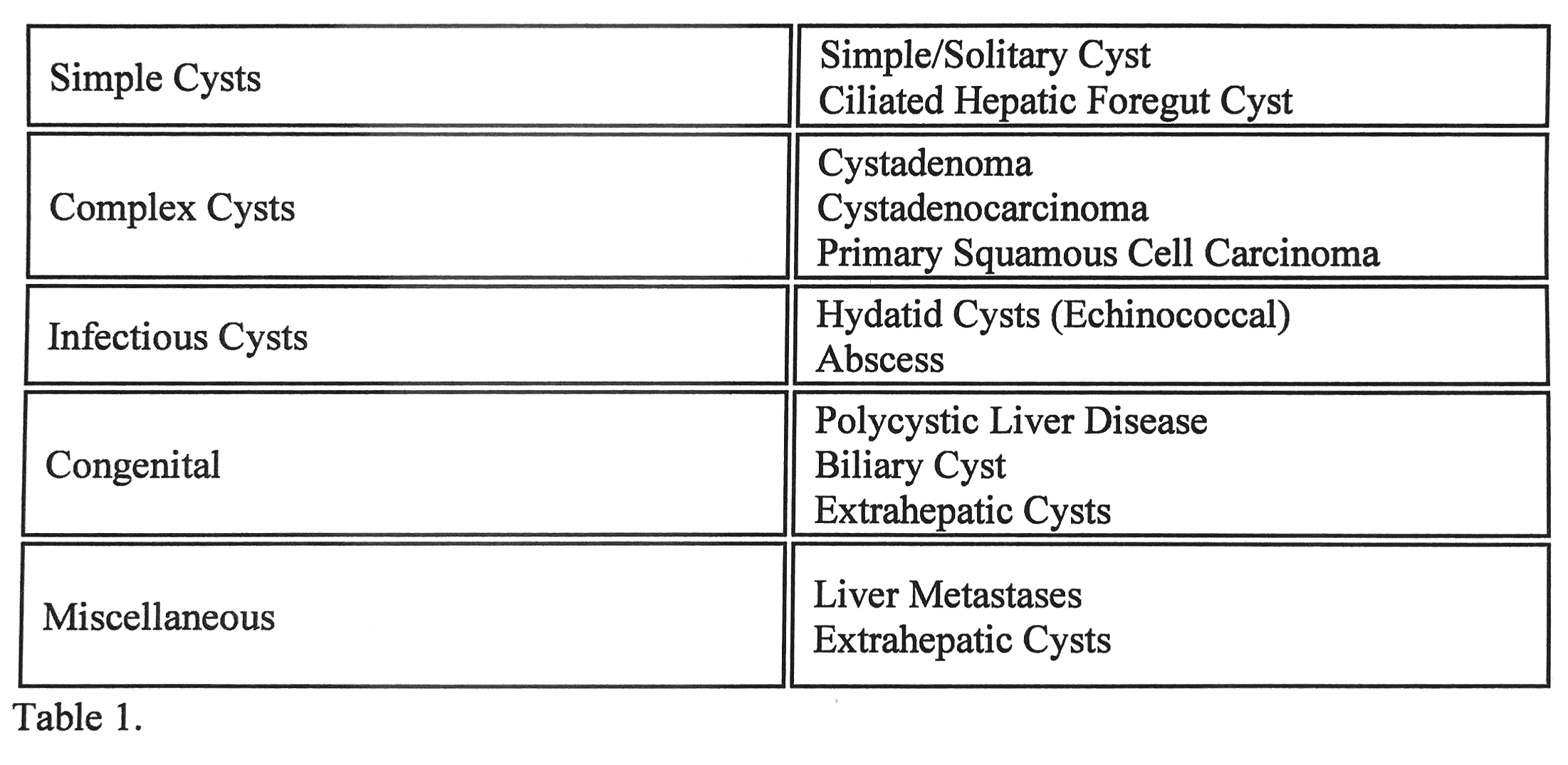[1]
Mavilia MG, Pakala T, Molina M, Wu GY. Differentiating Cystic Liver Lesions: A Review of Imaging Modalities, Diagnosis and Management. Journal of clinical and translational hepatology. 2018 Jun 28:6(2):208-216. doi: 10.14218/JCTH.2017.00069. Epub 2018 Jan 5
[PubMed PMID: 29951366]
[2]
Lembarki G, El Benna N. Echinococcal Cysts in the Liver. The New England journal of medicine. 2018 Jul 12:379(2):181. doi: 10.1056/NEJMicm1702005. Epub
[PubMed PMID: 29996075]
[3]
Recinos A, Zahouani T, Guillen J, Rajegowda B. Congenital Hepatic Cyst. Clinical medicine insights. Pediatrics. 2017:11():1179556517702853. doi: 10.1177/1179556517702853. Epub 2017 Apr 10
[PubMed PMID: 28469521]
[4]
Aussilhou B, Dokmak S, Dondero F, Joly D, Durand F, Soubrane O, Belghiti J. Treatment of polycystic liver disease. Update on the management. Journal of visceral surgery. 2018 Dec:155(6):471-481. doi: 10.1016/j.jviscsurg.2018.07.004. Epub 2018 Aug 23
[PubMed PMID: 30145049]
[5]
Paulsen JD Jr, Elgert P, Yee-Chang M, Wei XJ, Shi Y. Cytomorphologic features of echinococcal cysts. Diagnostic cytopathology. 2017 Aug:45(8):731-734. doi: 10.1002/dc.23733. Epub 2017 Apr 24
[PubMed PMID: 28440023]
[6]
Türkoğlu E, Demirtürk N, Tünay H, Akıcı M, Öz G, Baskin Embleton D. Evaluation of Patients with Cystic Echinococcosis. Turkiye parazitolojii dergisi. 2017 Mar:41(1):28-33. doi: 10.5152/tpd.2017.4953. Epub
[PubMed PMID: 28483731]
[7]
Martínez Ortiz CA, Jiménez-López M, Serrano Franco S. Biliary cysts in adults. 26 years experience at a single center. Annals of medicine and surgery (2012). 2016 Nov:11():29-31. doi: 10.1016/j.amsu.2016.08.016. Epub 2016 Aug 31
[PubMed PMID: 27656283]
[8]
Hasan A, Alrayashi W, Waisel D, Boretsky K. A Case Report of Incidental Hepatic Cysts Found on Ultrasound Imaging: Implications for the Anesthesiologist. A&A practice. 2018 Jan 15:10(2):33-35. doi: 10.1213/XAA.0000000000000627. Epub
[PubMed PMID: 28937424]
Level 3 (low-level) evidence
[9]
Lee DM, Kwon OS, Choi YI, Shin SK, Jang SJ, Seo H, Lee JJ, Choi DJ, Kim YS, Kim JH. [Spontaneously Resolving of Huge Simple Hepatic Cyst]. The Korean journal of gastroenterology = Taehan Sohwagi Hakhoe chi. 2018 Aug 25:72(2):86-89. doi: 10.4166/kjg.2018.72.2.86. Epub
[PubMed PMID: 30145861]
[10]
Sumer F, Kayaalp C, Polat Y, Ertugrul I, Karagul S. Transgastric removal of a polycystic liver disease using mini-laparoscopic excision. Interventional medicine & applied science. 2016 Jun 1:8(2):89-92. doi: 10.1556/1646.8.2016.2.3. Epub
[PubMed PMID: 28386465]
[11]
Smerieri N, Fiorentini G, Ratti F, Cipriani F, Belli A, Aldrighetti L. Laparoscopic left hepatectomy for mucinous cystic neoplasm of the liver. Surgical endoscopy. 2018 Feb:32(2):1068-1069. doi: 10.1007/s00464-017-5736-1. Epub 2017 Jul 21
[PubMed PMID: 28733729]
[12]
Yang C, Yang H, Deng S, Zhang Y. Intraperitoneal Rupture of Hepatic Hydatid Cysts. Journal of gastrointestinal surgery : official journal of the Society for Surgery of the Alimentary Tract. 2019 Jan:23(1):173-175. doi: 10.1007/s11605-018-3778-x. Epub 2018 Apr 20
[PubMed PMID: 29679343]
